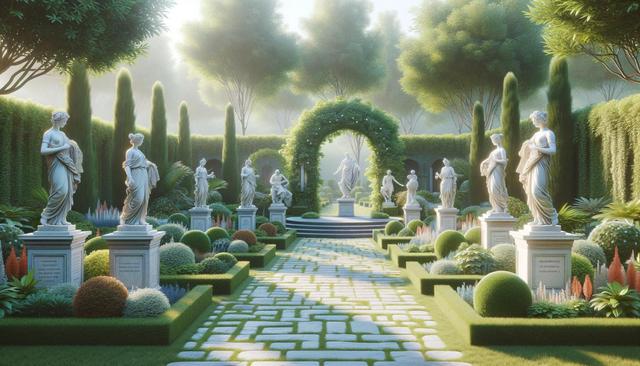The Historical Significance of Garden Statues
Garden statues have a long and rich history, dating back to ancient civilizations. From the meticulously carved marble figures of the Greeks to the symbolic sculptures in Asian temple gardens, these decorative elements have always played a symbolic and aesthetic role. In many cultures, garden statues were not only artistic expressions but also spiritual or cultural symbols. For example, Roman gardens often featured deities and mythological figures, reflecting the beliefs and values of the time. Today, while their meanings may vary, garden statues carry a legacy that connects modern landscapes with historical artistry.
The use of statues in gardens has evolved, but their purpose remains deeply rooted in storytelling, personalization, and visual interest. Many homeowners and landscape designers use garden statues to evoke a sense of timelessness or to create focal points that draw the eye. Whether inspired by classical themes or abstract forms, these statues continue to honor their historical past while fitting seamlessly into contemporary outdoor designs.
Materials and Styles to Consider
Choosing the right garden statues involves understanding the range of materials and styles available. Statues can be made from a variety of materials, each offering unique characteristics in terms of appearance, durability, and maintenance requirements. Common materials include:
- Stone: Offers a natural and weather-resistant option that blends well with most garden settings.
- Concrete: Durable and versatile, often used for larger statues and available in many finishes.
- Metal: Includes bronze, iron, and aluminum, known for their strength and ability to develop attractive patinas over time.
- Resin: Lightweight and affordable, suitable for smaller or intricately detailed statues.
Style is another important consideration. Traditional garden statues often feature classical figures, animals, or religious motifs. Modern designs may include abstract shapes or minimalist forms that complement contemporary landscaping. Whimsical statues, such as fairy-tale creatures or playful animals, are ideal for creating a light-hearted atmosphere. By choosing materials and styles that match the garden’s overall theme, you create a cohesive and visually appealing space.
Placement and Positioning for Visual Impact
The location of garden statues can significantly affect their impact. Strategic placement enhances the overall design of the garden and ensures that the statues contribute to the intended ambiance. When deciding where to place your garden statues, consider the following tips:
- Use statues as focal points in flower beds or open lawns to draw attention.
- Place smaller statues along pathways or near seating areas to create intimate visual interest.
- Frame statues with plants, hedges, or architectural elements to highlight them naturally.
- Ensure that the scale of the statue matches the surrounding space to maintain harmony.
Lighting also plays a key role in showcasing garden statues. Spotlights or solar garden lights can add dramatic shadows or soft illumination, extending their visual appeal into the evening. Proper positioning and thoughtful integration with landscape elements ensure that the statues enhance rather than disrupt the garden’s flow.
Maintenance and Seasonal Care
Maintaining garden statues is essential to preserving their beauty and structural integrity. Different materials require different levels of care. For instance, stone and concrete statues are relatively low maintenance but benefit from occasional cleaning to remove moss or dirt. Metal statues may need rust prevention treatments or protective coatings, especially in humid or rainy climates. Resin statues, while lightweight and easy to move, can be sensitive to extreme temperatures and may require indoor storage during winter months.
Basic maintenance practices include:
- Regularly dusting or rinsing off surface debris.
- Inspecting for cracks or damage caused by weather or pests.
- Applying sealants or protective finishes as recommended by the manufacturer.
- Storing fragile statues indoors during harsh seasons or securing them against strong winds.
By investing time in seasonal care, you can extend the lifespan of your garden statues and ensure they remain a cherished part of your landscape for years to come.
Personal Expression Through Garden Statues
One of the most compelling reasons to incorporate garden statues into your outdoor space is the opportunity for personal expression. These decorative elements allow you to reflect your tastes, interests, and personality in a tangible form. Whether you’re drawn to serene Buddha figures, cheerful animal sculptures, or artistic abstract pieces, the choices are nearly endless.
Garden statues can also commemorate special memories or represent values that are important to you. For instance, a statue of a child playing may symbolize family, while an angel can signify peace or remembrance. This emotional connection can enhance the meaning of your garden space and turn it into a more personal and reflective environment.
Moreover, incorporating garden statues as part of seasonal or thematic displays can bring dynamic energy to your outdoor area. Rotating statues or adding seasonal décor around existing ones helps keep the garden fresh and engaging throughout the year. This adaptability ensures that your garden is not only a beautiful retreat but also a continually evolving canvas of expression.








